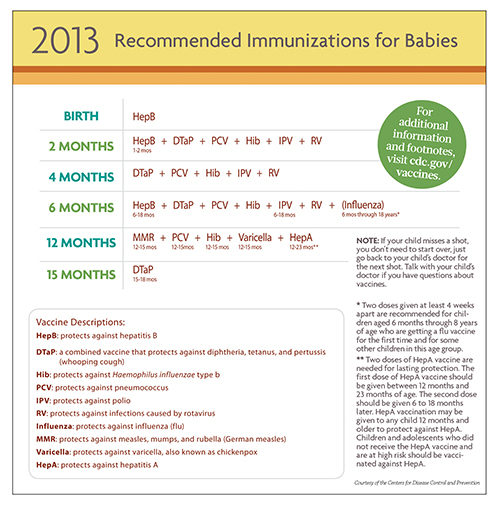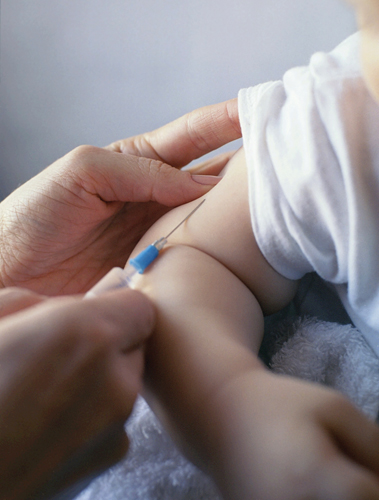Join the vacci-nation
Vaccines are not perfect. “Perfect” would be a world without […]
Vaccines are not perfect. “Perfect” would be a world without disease, where there would be nothing to prevent and nothing to cure. That’s not our world. Planet Earth is populated by mobile, microbe-toting individuals, who are constantly sharing what they’ve got—recipes, laughs, memories, and sometimes, serious illnesses.
Fortunately, as citizens of a 21st-century, first world country, we have the ability to deflect some of the more malicious handouts that come our way. The solution lies in vaccines. The U.S. Centers for Disease Control and Prevention (CDC) issues a schedule each year that provides an effective, defensive program for immunizing our children based on the most up-to-date information. Adhering to this schedule will give our kids the best disease protection available.
Risky behavior
Despite urging by the health community, there are parents who choose not to vaccinate their kids, believing that vaccines are unnecessary or even dangerous. Some parents opt to follow their own improvised immunization timeline rather than that set by the CDC. In response, the American Academy of Pediatrics (AAP) insists that when the CDC’s schedule is observed, vaccines are given in safe quantities and at proper intervals during a child’s development. Delaying vaccination only leaves the child vulnerable to disease unnecessarily.
AAP President Robert W. Block, MD, FAAP, advises parents to stick to the recommended immunization schedule: “As a pediatrician, I want to be sure parents today recognize the importance of immunization. We are giving immunizations to protect children from diseases that you may not see on a regular basis—because immunizations have worked.”
Parents who do not have their children vaccinated are depending upon those who do. Because most vaccine-preventable diseases are still found in foreign countries, they can be brought to the U.S. and spread among those who are not protected. Communities that do not embrace immunization are especially at risk.For example, Amish communities—wherein vaccination is not the norm— occasionally experience an outbreak of vaccine-preventable disease. Pertussis (whooping cough) broke out among the Amish in Kent County, Delaware, in the fall of 2004 to the winter of 2005. The Amish also experienced a widespread rubella outbreak in 1991, and a paralytic polio invasion in 1979. These case studies show that communities with a high percentage of unvaccinated individuals can become susceptible to disease.
To keep disease from appearing in your area, spread the word to other parents you know—vaccines work!
The fear factor
Immunization has been a hot topic in the parenting world recently. A few years ago, many were concerned that vaccines could be connected to the growing rate of autism. Since then, multiple studies have concluded that vaccines and autism are not correlated. The rise in autism and other spectrum disorders can be attributed to better detection and broadened diagnostic criteria. These disorders are still the basis of many studies, but so far, causes have been linked to genetics and abnormal fetal development in the womb. Other factors may include advanced parental age, maternal obesity during pregnancy, environmental triggers and premature birth.
Vaccines have also been blamed for causing the diseases they intend to prevent. At times, this has been true. When the polio vaccine was administered in a live oral dose (OPV), it infrequently resulted in a patient developing paralytic polio. Because of this, OPV has not been used in the United States since 2000. It has been replaced by IPV (inactivated poliovirus vaccine), a safer alternative.
There has also been much discussion about the harmful ingredients found in vaccines, particularly mercury and aluminum. Since 2001, thimerosal—a preservative containing mercury—has been removed from all routine childhood vaccines. Aluminum salts are currently used in vaccines to boost their efficacy, but the AAP assures, “The amount of aluminum in vaccines is similar to that found in 33 ounces of infant formula. Aluminum has been used and studied in vaccines for 75 years and is safe.” Aluminum is also found in breast milk and the foods we eat.
While some antivaccine rumors have been laid to rest, there is some real risk associated with vaccination. Occasionally, a child will spike a high fever after receiving routine shots, and rarely, this can result in febrile seizures that will require hospitalization. “The most serious [risk of adverse effects] is anaphylaxis—life-threatening allergic reaction—which is about 1 in 2 million,” says Ari Brown, MD, FAAP, pediatrician and co-author of Baby 411.
Until we live in a perfect world where contagious diseases have been completely eradicated, vaccines are our best shot at keeping our children healthy. Brown says, “It’s important for parents to know that there are risks, but that the benefits far outweigh them. We take those risks to protect our kids—and there is no question that I would do it again for my own kids in a heartbeat.”









